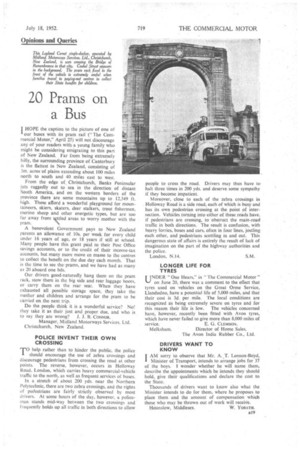20 Prams on a Bus
Page 53

If you've noticed an error in this article please click here to report it so we can fix it.
I HOPE the caption to the picture of one of I our buses with its pram rail •(" The Commercial Motor," April 25) will not discourage any of your readers with a young family who might be considering emigrating to this part of New Zealand. Far from being extremely hilly, the surrounding province of Canterbury is the flattest in New Zealand, consisting of 3m. acres of plains extending about 100 miles north to south and 40 miles east to west.
From the edge of Christchurch, Banks Peninsular juts ruggedly out to sea in the direction of distant South America, and on the western borders of the province there are some mountains up to 12,349 ft. high. These afford a wonderful playground for mountaineers, skiers, skaters, deer stalkers, trout fishermen, merino sheep and other energetic types, but are too far away from Xled areas to worry mother with the pram.
A benevolent Government pays to New Zealand parents an allowance of 10s. per week for every child under 16 years of age, or 18 years if still at school. Many people have this grant paid to their Post Office savings accounts, or to the credit of their income-tax accounts, but many more move en masse to the centres to collect the benefit on the due day each month. That is the time to see the' prams, and we have had as many as 20 aboard one bils.
Our drivers good-naturedly hang them on the pram rack, stow them in the big side and rear luggage boots, or carry them on the rear seat. When they have exhausted all possible storage space, they take the mother and children and arrange for the pram to be carried on the next trip.
Do the people think it is a wonderful service? No! they take it as their just and proper due, and who is
to say they are wrong? J. J. B. CONNOR, Manager, Midland Motorways Services, Ltd. Christchurch, New Zealand.
POLICE INVENT THEIR OWN CROSSING TO help rather than to hinder the public, the police I should encourage the use of zebra crossings and discourage pedestrians from crossing the road at other points. The reverse, however, occurs in Holloway Road, London, which carries heavy commercial-vehicle traffic to the north, as well as frequent services of buses.
In a stretch of about 200 yds. near the Northern Polytechnic, there are two zebra crossings, and the rights of pedestrians are fairly strictly observed by most drivers. At some hours of the day, however, a policeman. stands mid-way between the two crossings and frequently holds up all traffic in bath directions to allow people to cross the road. Drivers may thus have to halt three times in 200 yds. and deserve some sympathy if they become impatient.
Moreover, close to each of the zebra crossings in Holloway Road is a side road, each of which is busy and has its own pedestrian crossing at the point of intersection. Vehicles turning into either of these roads have, if pedestrians are crossing, to obstruct the main-road traffic in both directions. The result is confusion, with heavy lorries, buses and cars, often in four lines, jostling each other, and pedestrians scuttling in and out. This dangerous state of affairs is entirely the result of lack of imagination on the part of the highway authorities and the police.
London. N.14. S.M.
LONGER LIFE FOR TYRES
UNDER "One Hears," in The Commercial Motor" on June 20, there was a comment to the effect that tyres used on vehicles on the Great Orme Service, Llandudno, have a potential life of 5,000 miles, and that their cost is 3d. per mile. The local conditions are recognized as being extremely severe on tyres and for this reason their life is low. The vehicles concerned have, however, recently been fitted with Avon tyres, which have never failed to give more than 8,000 miles of service. E. G. CLEMSON,
Melksham. Director of Home Sales, The Avon India Rubber Co., Ltd.
DRIVERS WANT TO KNOW AM sorry to observe that Mr. A. T. Lennox-Boyd, Minister of Transport, intends to arrange jobs for 37 of the boys. I wonder whether he will name them, describe the appointments which he intends they should hold, give their qualifications and declare the cost to the State.
Thousands of drivers want to know also what the Minister intends to do for them, where he proposes to place them and the amount of compensation which those who may be thrown out of work will receiVe.
Hounslow, Middlesex. W. YORATH.




























































































